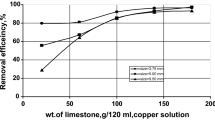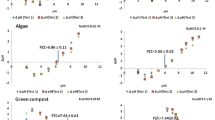Summary
The adsorption of phosphate ion from two different phosphate solutions by hydrous ferric, aluminium and chromium oxides has been investigated. In view of the difference in the characteristics of the hydrous oxides caused by the amount of alkali used for precipitation, three samples of each have been prepared and used as adsorbents.Freundlich's isotherm rule is not obeyed with the samples showing the complicated nature of the fixation process. The curves are, however, similar in nature which might be taken to suggest that identical interactions are occurring between the phosphate solutions and the hydrous oxides leading to the formation of chemical compound-like products. It seems that in every case the process involves the intake of phosphate ion resulting in a corresponding release of hydroxyl ions.
With samples of the hydrous oxides which are precipitated with less of alkali, the association of phosphate ion is more marked. This is postulated to be due to the predominence in the basic character of the hydrous oxide.
Samples of hydrous oxides precipitated by sodium hydroxide have been found to be less reactive in phosphate fixation than those precipitated by ammonium hydroxide. This has been explained on the basis that sodium hydroxide being a stronger base than ammonium hydroxide helps formation of a product of M2O n type which has less chemical reactivity. Higher fixation of phosphate from aluminium phosphate than ferric phosphate and also higher reactivity of hydrous chromium oxide in relation to phosphate fixation have been judged from the point of view of pH and conductivity of ions of the hydrous oxides and the phosphate solutions.
Less fixation of phosphate from ferric phosphate by hydrous ferric oxide and from aluminium phosphate by hydrous aluminium oxide has been conjectured to be due to antagonism between similar cations of the adsorbent and the adsorbate.
Zusammenfassung
Die Adsorption von Phosphat-Ionen aus zwei verschiedenen Phosphatlösungen durch wäßrige Eisen-, Aluminium- und Chromoxide wurde untersucht. Im Hinblick auf die Unterschiede in den Charakteristiken der wäßrigen Oxide, verursacht durch den Betrag an Alkali, der zu ihrer Fällung gebraucht wurde, haben wir jeweils drei Proben präparariert und als Adsorbenten verwendet. DieFreundlich-Isotherme ist von den Proben, die eine komplizierte Art des Fixierungsprozesses zeigen, i. allg. nicht erfüllt. Die Kurven ähneln jedoch einander, was vermuten läßt, daß identische Wechselwirkungen zwischen den Phosphatlösungen und den wäßrigen Oxiden ablaufen, die zur Bildung von chemischen Verbindungen ähnlichen Produkten führen. Es scheint, daß der Prozeß immer die Aufnahme von Phosphat-Ionen mit einem entsprechenden Verlust an Hydroxyl-Ionen einschließt.
Mit Proben wäßriger Oxide, welche mit wenig Alkali gefällt wurden, ist die Assoziation von Phosphat-Ionen stärker ausgeprägt. Dies wird dem vorherrschenden basischen Charakter der wäßrigen Oxide zugeschrieben.
Proben von wäßrigen Oxiden, ausgefällt mit Natriumhydroxid wurden als weniger wirksam für die Phosphatfixierung gefunden als solche, ausgefällt mit Ammoniumhydroxid. Dies ist so erklärbar, daß das Natriumhydroxid — als stärkere Base als das Ammoniumhydroxid — bei der Bildung eines Produktes vom M2O n -Typ hilft, das weniger chemische Wirksamkeit hat. Höhere Fixierung von Phosphat aus Aluminiumphosphat statt aus Eisenphosphat und auch höhere Reaktionsfähigkeit des wäßrigen Chromoxids in Beziehung auf die Phosphatfixierung werden vom Standpunkt des pH und der Ionenleitfähigkeit der wäßrigen Oxide in der Phosphatlösung gerechtfertigt.
Geringere Fixierung von Phosphat aus Eisenphosphat mit wäßrigem Eisenoxid und aus Aluminiumphosphat mit wäßrigem Aluminiumoxid sind vermutlich dem Antagonismus zwischen ähnlichen Kationen von Adsorbent und Adsorbat zuzuschreiben.
Similar content being viewed by others
References
Voelcker, A., J. Roy. Agric. Soc.24, 27 (1863).
Fraps, G. S., Texas Agric. Expt. Sta. Bul. 304 (1922).
Dean, L. A., Soil Sci.37, 253 (1934).
Ford, M. C., J. Amer. Soc. Agron.25, 134 (1933).
Weiser, V. L., Vt. Agric. Expt. Sta. Bul. 356 (1933).
Gile, P. L., U. S. Dept. Agric. Tech. Bul. 371 (1933).
Warington, R., J. Chem. Soc.21, 1 (1868).
Blanchet, R., Compt. rend. Acad. Sci. Paris248, 1028 (1959).
Swenson, R. M., C. V. Cole andD. H. Sieling, Soil Sci.67, 3 (1949).
Dhar, B. K., Doctoral Thesis, Univ. Alld., India (1954).
Hajela, R. B., Doctoral Thesis, Univ. Alld., India (1958).
Kelley, J. B. andA. R. Midgley, Soil Sci.55, 167 (1943).
Dey, A. K. andS. Ghosh, J. Ind. Chem. Soc.27, 66 (1950).
Dey, A. K. andS. Ghosh, J. Ind. Chem. Soc.24, 181 (1947).
Dey, A. K. andS. Ghosh, Proc. Nat. Acad. Sci. (Ind.)17 A, 93 (1948).
Dey, A. K. andS. Ghosh, Proc. Ind. Sci. Cong., Part III, Abstract Chem. Sec. (1951).
Author information
Authors and Affiliations
Rights and permissions
About this article
Cite this article
De, S.K. Adsorption of phosphate ion by hydrous ferric, chromic and aluminium oxides. Kolloid-Zeitschrift 179, 134–140 (1961). https://doi.org/10.1007/BF01520101
Received:
Issue Date:
DOI: https://doi.org/10.1007/BF01520101




